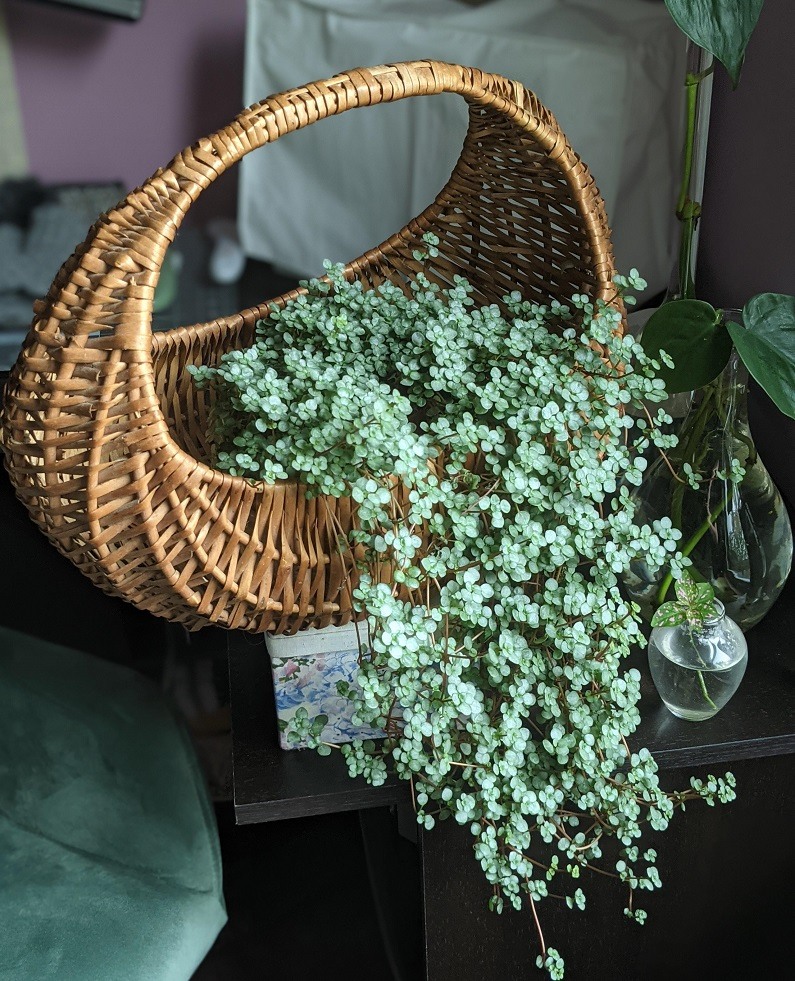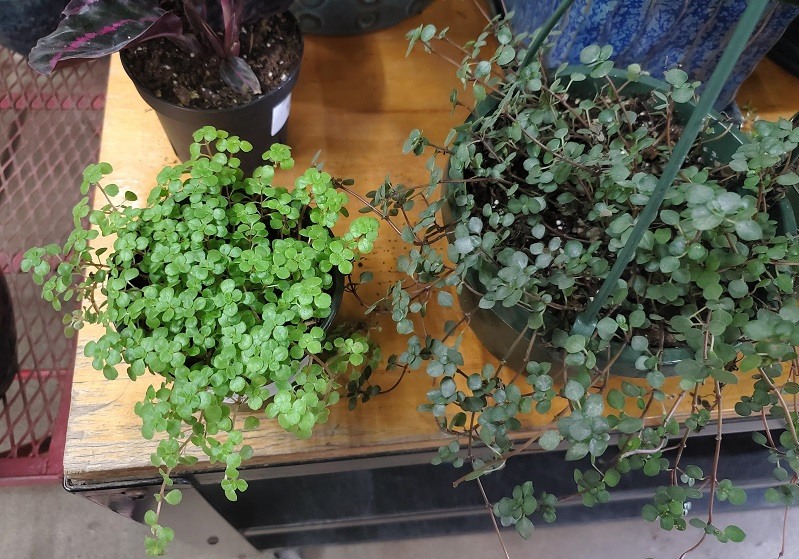Pilea glauca is a rare houseplant variety without an official botanical name. But the demand for the houseplant is gradually growing among many Americans. Thanks to its cascade of mini-leaves with sprinkled silver dust.
Pilea galuca care involves the provision of bright indirect sunlight, well-draining potting mix, room temperature, average humidity, and light fertilization. The indoor plant also thrives under moderate moist soil but never a damp environment.
I wrote this comprehensive guide to help you learn how to care for the pilea glauca plant as a profession. The article also highlights common problems affecting the houseplant with their respective solutions. Let’s find out that together now.
You May Also Like: How to Care for Philodendron Xanadu

What Does Pilea Glauca Looks Like?
The pilea glauca plant provides an excellent thick ground cover and trails ideal for hanging baskets. Thanks to its long and red-hue stems.
The houseplant also has petite, oval, and blue-grey foliages that shimmer with silvery powder. It is another reason behind the growing demand in the market today.
This attractive succulent plant can tolerate both indoor and outdoor conditions. It is native to the Caribbean, Central America, and Brazil.
Many houseplant stores sell the species under pilea libanensis. Other common names associated with the houseplant are pilea silver sparkle, grey baby tears, and red-stemmed pilea.
The grey artillery is another common name associated with the houseplant. it is due to the tiny flowers having stamens that burst open when watering.
The houseplant matures after three years and grows up to three feet tall. It stays small and versatile for desktops, hanging basket centerpieces, and landscaping.
The indoor plant is non-toxic to humans and pets. It is the perfect option for a terrarium due to the blue-green leaf color that contrasts with other green plant collections.
Pilea Glauca Care Details
| Origin | Caribbean, Central America and Brazil |
| Scientific Name | Pilea libanensis |
| Common Names | Grey Baby Tears Red-stemmed Pilea Pilea Silver Sparkle Grey Artillery |
| Light Requirements | Bright indirect sunlight. 1-2 hours for direct sunlight early morning or late evening. |
| Watering Needs | Consistent soil moisture. Super sensitive to water quality and overwatering. |
| Potting Soil Type | Light and well-draining soil. Mix equal parts of peat and perlite. |
| Temperature Range | 70-80oF (21-26oC). Not tolerant to freezing temperatures. |
| Fertilizer Application | Feed the plant monthly during spring and summer with balanced fertilizer. |
| Humidity Requirements | Medium to high levels |
| Bloom | Produce clusters of small, nondescript white, pink, or beach flowers along its stems. |
| Pruning | Minimal to none. Remove dead or damaged leaves to maintain shape and size. |
| Propagation | Stem cutting and root in either water or soil. |
| Repotting | Transplant pilea glauca in case of root-bound signs. |
| Pests and Diseases | Pests: Scales, mealybugs, aphids, and spider mites. Diseases: Root rot due to overwatering, leaf spot, southern blight, and botrytis. |
| Toxicity | Non-toxic to humans and pets |
How to Care for Pilea Glauca Plant
Pilea Glauca Light Requirements
Bright indirect sunlight is an essential pilea glauca care requirement. But 1-2 hours of direct sunlight in the early morning and late evening is a perfect option.
Too much direct sunlight will scorch the delicates and make the succulent stems wither. Besides that, low light makes the plant leggy and experiences stunted growth.
Place your houseplant near the window with curtains or shears to experience bright indirect sunlight. Use artificial light sources in rooms receiving inadequate natural light.
How to Water Pilea Glauca
Grey artillery thrives in slightly moist soil that never stays dry or soggy. Pilea glauca is a succulent plant that is not tolerant to drought.
A damp environment increases the risk of root rot. Soggy potting medium occurs due to regular watering without inspecting current moisture level.
The golden rule is to insert the index finger in the topsoil about 2-3 inches to determine the soil moisture level. Soak the potting soil if the topsoil is dry until the water runs through the drainage holes.
Allow the pot to sit in the sink to drain excess water. An inappropriate watering routine will result in yellow leaves and leaf loss. (Check Best Self-Watering Planters on Amazon).
Best Water Quality for Pilea Glauca
The red-stemmed pilea are super sensitive to mineralized water. The white spots on the pilea glauca leaves occur due to chlorine and fluoride minerals in tap water.
I recommend the use of distilled water and rainwater or any other source of ideal water. It is the best option to keep the houseplant healthy and happy.
Allow the tap water to stay overnight before watering your houseplant. The option makes the minerals settle down in the container.
Best Soil Mixture for Pilea Glauca
Pilea glauca flourishes in fluffy and well-draining potting soil. The soil structure allows proper drainage and root aeration after a thorough watering.
Use an equal amount of peat and perlite to make the potting medium. I recommend the addition of compost or organic matter to increase soil fertility.
Pilea Glauca Humidity Requirement
The red-stemmed pilea plant can tolerate indoor humidity conditions. But the plant thrives in high humidity that mimics its native habitat.
Maintaining indoor humidity levels during winter and summer can be a daunting experience. Low humidity makes the houseplant leaves crispy and brown edges or appears dry.
Group the houseplants to increase humidity due to transpiration. An alternative option is to install a humidifier to boost indoor humidity levels.
Pilea Glauca Temperature Requirement
Grey baby tear thrives under room temperature at home. This tropical plant prefers a temperature range of 70-80oF (21-26oC) and can still adapt to a temperature of 50oF.
The pilea silver sparkle cannot tolerate frost. Maintain the indoor temperature to the required standards throughout the year.
The best option is to keep the houseplant away from radiators, heaters, and air vents. These climatic conditions make the houseplant unhealthy and unhappy.
Pilea Glauca Fertilizer
Regular fertilizer application every month during spring and summer is recommendable. It helps to encourage vegetative and active growth.
Over-fertilization causes excessive accumulation of salt around the root systems. It later causes roots and leaves to burn. Consider flushing the potting soil in such a situation.
I recommend the use of water-soluble and balanced fertilizer. Small monthly doses are better than large seasonal doses. Ensure the fertilizer is rich in nitrogen and phosphorous.
Organic fertilizer is an excellent alternative to artificial fertilizers. It helps to reduce the risk of over-fertilization. Find out How to Make Homemade Fertilizers for Houseplants.
Pilea Glauca Flowers
Healthy grey artillery that receives bright indirect sunlight to produce small nondescript white, pink, or beach flowers along its stems.
Pilea glauca bloom in late spring due to the active growing season. But these flowers are not the striking highlights of the houseplant.
The small shell burst to release harmless pollen into the air while watering. I recommend the use of a face mask (Check Best Deals on Amazon) for those suffering from pollen grains allergy.
Pruning and Maintenance
Pilea glauca pruning and maintenance is a no-brainer task. It involves the removal of dead or damaged leaves to shape the houseplant.
I recommend pruning the houseplant when grown as a ground cover. It helps to improve air circulation and landscaping appearance.
Use sharp shears (Check Best Deals on Amazon) to cut leaf stems attached to the main branch. Be sure to sterilize the shears by rubbing with isopropyl to avoid the spreading of pathogens.
How to Repot Pilea Glauca
Pilea glauca plant does not require regular transplant since it is less vulnerable to root-bound problems. I recommend transplant in case of root rot and over-fertilization.
Repotting pilea silver sparkle is a daunting and challenging experience. The chance of stressing and killing the houseplant is super high.
Remove the houseplant from the pot with ultimate care during the spring season. Repot the houseplant to a slightly large pot with fresh potting soil.
Water the indoor plant more often and place it in a region that receives bright indirect sunlight. It will take a couple of weeks to grow back to normal.
How to Propagate Pilea Glauca
Pilea glauca propagation involves cutting 1-2 inch stems above the node and stripping the few bottom leaves. It roots faster in either soil or water.
Juvenile growth is the best option for cutting and rooting in soil rather than water. Ensure the potting medium is similar to the parent soil.
Water the plant well and provide sufficient sunlight. Remember to maintain high humidity and proper aeration to avoid rot or molds.
Common Problems and Solutions
Pests
Pilea glauca plants are more vulnerable to houseplant pests. These sap-sucking insects usually deform the foliages and ruin their stunning appearance.
Spider mites, scales, aphids, and mealybugs are the common houseplant pests that attack pilea silver sparkle plants. Inspect your houseplant foliages to confirm the presence of pests.
Use a horticultural oil or insecticidal soap to get rid of pests from your houseplant. Remember to isolate the plant from others to prevent spreading.
Diseases
Excess moisture around the houseplant causes botrytis, leaf spot, root rot, and southern blight. It occurs due to overwatering and maintenance of high humidity.
Use a well-draining potting mix and allow it to dry between watering. Ensure the room is well-ventilated to prevent plant diseases from occurring.
Frequently Asked Questions
Is Pilea Glauca Toxic to Humans and Pets?
No. Pilea glauca is safe for humans and pets. But I prefer keeping the indoor plant away from toddler and pets to avoid destruction.
Why Are My Pilea Glauca Leaves Falling Off?
Inappropriate watering routine and low light conditions are the leading cause of leaves falling off from the Pilea glauca. Change your watering regime and provide bright indirect sunlight.
Other possible causes are old age, acclimation, transplant shock, low humidity, and extreme indoor temperature changes. Investigate your houseplant to identify the exact cause.
Why Is My Pilea Glauca Dying?
Overwatering and direct sunlight exposure may cause Pilea glauca death. Overwatering leads to root rot disease, and direct sunlight scorches the houseplant.
Other potential causes are under-watering, low humidity, freezing, and high temperatures. Take the time to investigate the plant and identify the exact cause.

Final Word
Pilea glauca also known as Silver Sparkle Pilea is an amazing houseplant with hundreds of cascading gray leaves. Growing and maintaining the houseplant is super easy.
I hope this comprehensive guide on how to care for the pilea glauca will help you to become a successful grower. But the houseplant does not require special attention
